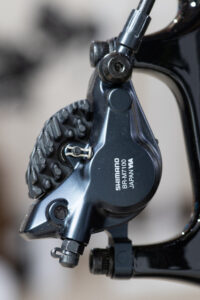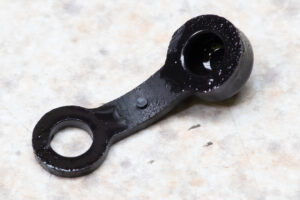
It seems the design of the bleed nipple on Shimano hydraulic disc brakes may result in contamination of the brake pads if extra care isn’t taken to clean residual oil from inside the nipple after bleeding the brakes. Newer Shimano hydraulic calipers, such as the Shimano BR-M7100 (SLX), have this nipple facing downward when installed on most bikes which seems to exacerbate the issue.
After following the Shimano brake bleed procedure and disconnecting the hose, the nipple will still contain about 0.06 mL of brake fluid, roughly a full drop, closed only by a snap-fit rubber cap. (See exploded view, inside of nipple is ~20mm x ~2mm ⌀.) On many brakes, including the BR-M7100 when mounted to a fork or seatstay, the nipple points downward and the residual oil inside slowly weeps out, wetting the outside of the cap and the caliper. Particularly after mixing with dust and forming an oily paste this can fling to the rotor or pads, contaminating the pads, leading to poor performance and noise.
On other Shimano brakes, such as the the BR-M8000, the bleed nipple is on the other end of the caliper. These point up and don’t seem to weep residual oil as readily. However, because bikes are stored and transported in a variety of positions, much less bounced all over the place while riding, any oil in the nipple can cause escape.
To avoid self-contamination it’s necessary to remove all residual oil from inside of the bleed nipple after a bleed. This can be done by twisting the corner of a paper towel into a point, shoving it into the nipple, and blotting the oil up. A couple iterations of this and thorough cleaning of the caliper and inside of the nipple with isopropyl alcohol seems sufficient. After doing this the nipple caps on our bikes have remained dry.

I came to this realization after a handful of dusty rides on the Timberjack when I noticed this cap had a bunch of dark oil-soaked dust on it. A quick check showed the inside of the cap was quite oily. There was also a thin film of oil wicking on to the bleed nipple and caliper body. As the bike is nearly new the brakes had recently been bled and the outside of the calipers thoroughly cleaned, it all fit together. (I suspect this may have led to the contamination problems I had earlier with the pads, although those pads themselves seemed bad from the get-go.)
On Kristen’s fatbike — a 2018 Specialized Fatboy Carbon Comp which received M7100 SLX brakes to replace the failed SRAM Level TLs but has only been kept upright since the brake install — the front brake whose nipple points down had oil in the cap. The rear brake, mounted to the chainstay and pointing the nipple up, was dry, but still had visible oil in the nipple.
This could also explain a mysterious fouled-front-brake problem on my Warbird, whose BR-R7070 (105) calipers have a downward facing bleed port on the front and upward facing on the rear. This was fixed with a sanding of the rotor and pad replacement, but I could not find a source of oil and the system seemed sealed. I now believe residual oil migration past the rubber cap, after I bled the brakes following a fork replacement, fouled the pads.